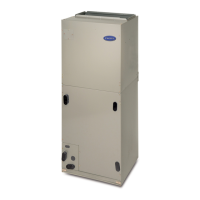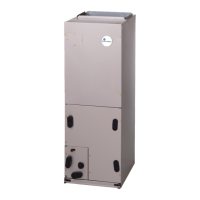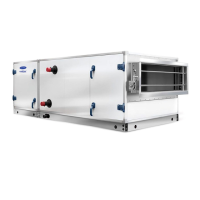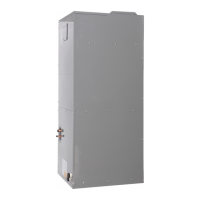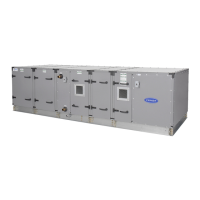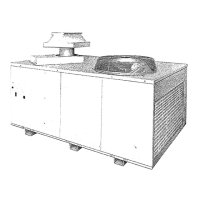FCM4, FEV, FEM4, FJM, FMA4, FSA4, FSM4, FSU4, FVM4, FXM4, REM4, WAH, WAM, WAP, WAX, WBHL: Service and Maintenance Instructions
Manufacturer reserves the right to change, at any time, specifications and designs without notice and without obligations.
14
STATUS CODE 36, HEATER OUTPUT NOT SENSED WHEN
ENERGIZED:
Fan coil control is provided with circuitry to detect presence of a 24VAC
signal on Electric Heater stage 1 and stage 2 outputs.
If fan coil control energizes either heater stage and does not detect the
24VAC signal on output, Status Code 36 will be displayed on the
STATUS LED Fan coil control will continue to energize heater output(s)
and adjust blower operation to a safe airflow level for energized electric
heat stage(s).
To find the fault, check for 24VAC on heater stage outputs. Fan coil
control or sensing circuit may be bad.
NOTE: It may be useful as an electric heater troubleshooting procedure
to disconnect the system communications to force Status Code 16
enabling of emergency heat mode. It is difficult to know which heater
output is energized or not energized in normal operation. When fan coil
is operated in emergency heat mode using electric heaters, both outputs
are energized and de-energized together. Terminal strip inputs to control
can then be connected R to W to turn on both electric heat outputs.
Heater output sensing circuits can then be checked to resolve Status
Code 36 or 37 problems.
STATUS CODE 41, BLOWER MOTOR FAULT:
If MOTOR LED is lit and flashing and motor does not run:
1. Check STATUS LED. If STATUS LED is indicating Status Code
41, motor control has detected that the motor will not come up to
speed within 30 seconds of being commanded to run or that the
motor has been slowed to below 250 rpm for more than 10 seconds
after coming up to speed. Motor wiring harness and fan coil control
are operating properly, do not replace.
2. Check to be sure that the blower wheel is not rubbing the housing.
3. Check motor to be sure that the motor shaft is not seized (motor
control module must be removed and electronics disconnected from
windings to perform this check properly).
4. Check motor windings section following instructions in ECM
Motor Troubleshooting on pg 12.
If all these checks are normal, the motor control module may need
replacement.
STATUS CODE 16, SYSTEM COMMUNICATION FAULT:
If, at any time, system communications are not successful for a period
exceeding two minutes, the fan coil control will only allow emergency
heating or cooling operation using a common thermostat, a
non-communicating outdoor unit, and the R, C, Y, O, W outdoor unit
terminal strip connections and will display Status Code 16 on the amber
STATUS LED (see Emergency Heating and Cooling Modes on pg 14).
No further fan coil troubleshooting information will be available at the
Observer wall control until communications are reestablished.
Check system wiring to be sure the Observer wall control is powered and
connections are made DX+ to DX+, DX- to DX- etc. and wiring is not
shorted. Mis-wiring or shorting of the DX+, DX-, C, R communications
wiring will not allow successful communications. Correcting wiring
faults will clear the code and reestablish communications.
Shorting or mis-wiring the low voltage system wiring will not cause
damage to fan coil control or to Observer wall control but may cause the
low voltage fuse to open.
STATUS CODE 46, BROWNOUT CONDITION:
If the secondary voltage of the transformer falls below 15VAC for a
period exceeding four seconds, Status Code 46 will be displayed on
STATUS LED.
If system includes a non-communicating outdoor air conditioner or heat
pump, the Observer wall control will command the fan coil to turn off Y
output controlling compressor.
When secondary voltage rises above 17VAC for more than four seconds,
the brownout condition is cleared and normal system operation will
resume subject to any minimum compressor off delay function which
may be in effect. Brownout does not affect blower or electric heater
operation.
STATUS CODE 53, OUTDOOR AIR TEMPERATURE SENSOR
FAULT:
If an OAT sensor is found at power-up, input is constantly checked to be
within a valid temperature range. If sensor is found to be open or shorted
at any time after initial validation, Status Code 53 will be displayed at
amber STATUS LED.
Check for faults in wiring connecting sensor to OAT terminals. Using an
Ohmmeter, check resistance of thermistor for a short or open condition.
If thermistor is shorted or open, replace it to return the system to normal
operation. If fault is in the wiring connections, correcting the fault will
clear the code and return the system to normal operation.
NOTE: If fault condition is an open thermistor or a wiring problem that
appears to be an open thermistor and the power to the fan coil control is
cycled off, the fault code will be cleared on the next power-up but the
fault will remain and system operation will not be as expected. This is
because on power-up, the fan coil control cannot discern the difference
between an open sensor or if a sensor is not installed.
Emergency Heating and Cooling Modes
Fan coil control can provide emergency heating or cooling using a
common heat/cool thermostat in the event that there are no system
communications, fault is in Observer wall control and no replacement is
immediately available.
To activate these modes, the thermostat and outdoor unit must be wired
as a common heating/cooling system to fan coil control RYWC
terminals. Fan coil control must be powered and displaying Status Code
16, System Communication Fault.
NOTE: These emergency modes do not provide the level of comfort and
efficiency expected by the consumer and should only be activated when
Observer wall control cannot be replaced immediately.
SEQUENCE OF OPERATION
The FCM4 fan coil is designed for installation with Observer
communicating wall control. This fan coil will not respond to commands
provided by a common thermostat except under certain emergency
situations described in the Start Up and Troubleshooting sub-section.
The Observer wall control uses temperature; humidity and other data
supplied from indoor and outdoor system components to control heating
or cooling system for optimum comfort.
ADVANCED TROUBLESHOOTING:
Troubleshooting the FCM4 Fan Coil Circuit Board:
The circuit board Fan Coil part number 1184554
Primary test that should be performed:
Motor Line Voltage Check
1. Turn off power (240V).
2. Remove Plug 3 from ECM motor.
3. Turn on power.
Table 6 – FCM4 Self-Identifying Resistor Values
Heater Size kW Resistor Ohms Nominal
No heater Open
9 11k
15 18k
20 24k
24 33k
30 39k
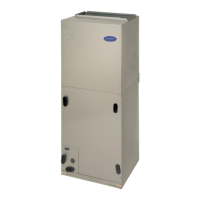
